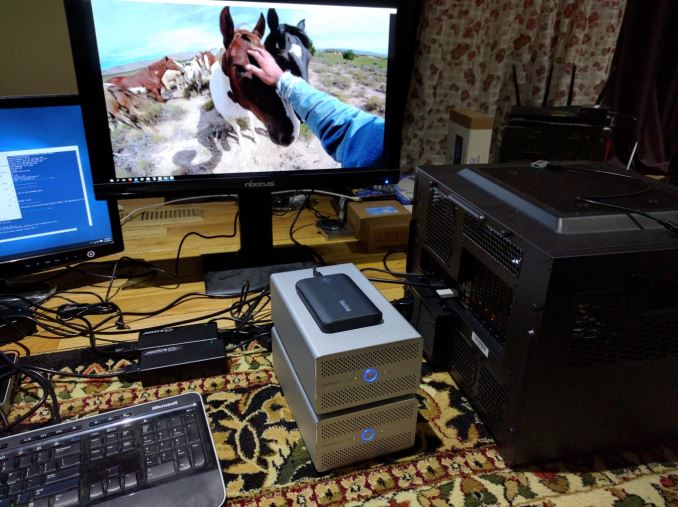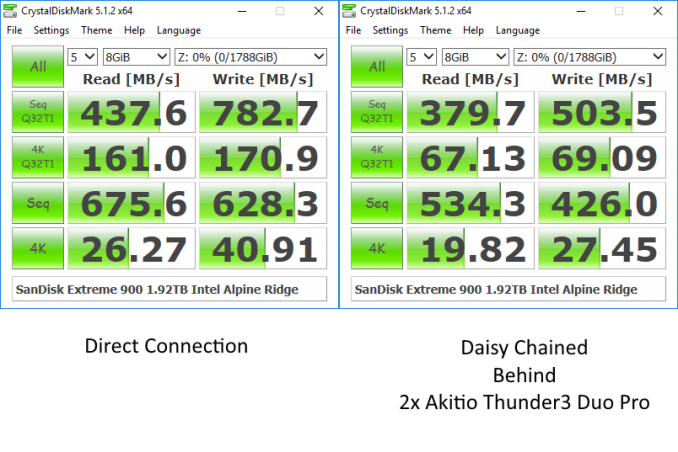Thunderbolt 3 in Action: Akitio Thunder3 Duo Pro DAS Review
by Ganesh T S on April 14, 2016 8:30 AM EST- Posted in
- Storage
- DAS
- Thunderbolt 3
- Akitio
Daisy Chaining
The full capabilities of Thunderbolt 3 are brought out when we have a series of devices hooked up in a daisy chain fashion to the testbed. Thunderbolt has always supported DisplayPort monitors at the end of a daisy chain. With Thunderbolt 3, any USB device with a Type-C interface can terminate the chain. The design of the Akitio Thunder3 Duo Pro ensures that a DisplayPort monitor does not need to be a link in the daisy chain, but can hang off as a node. We performed some testing with the following daisy chain configuration:
- AnandTech Skylake DAS Testbed with 2x Thunderbolt 3 (TB3) ports
- TB3 Port 1 of testbed connected to TB3 Port 1 of Akitio Thunder3 Duo Pro A
- TB3 Port 2 of Thunder3 Duo Pro A connected to TB3 Port 1 of Thunder3 Duo Pro B
- Nixeus Vue-27D 2560x1440 DisplayPort monitor connected to DisplayPort output of Thunder3 Duo Pro B
- SanDisk Extreme 900 1.92TB connected to TB3 Port 2 of Thunder3 Duo Pro B
The daisy chain setup is brought out in the photograph below.
IOMeter is one of the most reliable tools to measure performance while accessing multiple storage nodes simultaneously. In order to get maximum performance, we set up the two Akitio Thunder3 Duo Pro units in JBOD mode. Including the SanDisk Extreme 900, we ended up with five different physical disks that could be accessed over the single Thunderbolt 3 link. We ran the standard 128K sequential accesses with a queue depth of 4 and the 4K random accesses with a queue depth of 32. The table below shows the bandwidth realized as a function of the number of disks accessed simultaneously.
| 2x Akitio Thunder3 Duo Pro with 4x Intel SSD DC S3510 + SanDisk Extreme 900 (Thunderbolt 3 + USB 3.1 Gen 2 Daisy Chaining) IOMeter Benchmarks (MBps) |
||||
| Number of Simultaneous Disk Accesses | Write Bandwidth | Read Bandwidth | ||
| 128K Seq QD4 | 4K Rand QD32 | 128K Seq QD4 | 4K Rand QD32 | |
| 1 | 243.30 | 45.39 | 334.51 | 226.95 |
| 2 | 508.89 | 198.69 | 671.14 | 178.00 |
| 3 | 749.80 | 199.19 | 943.28 | 159.88 |
| 4 | 1010.37 | 160.12 | 1229.20 | 131.81 |
| 5 | 1489.72 | 172.68 | 1761.13 | 153.85 |
The sequential access numbers show that the link is nowhere near getting saturated despite pushing across more than 1700MBps (not accounting for the DisplayPort bandwidth here). However, with two bay devices supporting only SATA drives, it is difficult to sustain more traffic than what we have recorded here. That said, as more peripherals start coming out (in the form of docks or even units with 10+ drive bays), Thunderbolt 3 can show its true benefits.
Performance Implications
Daisy chaining is a nifty feature, but users must realize that as one goes further down the chain, the performance of the peripheral decreases. We studied this aspect further by using the SanDisk Extreme 900 USB 3.1 Gen 2 Portable SSD. In our first test, we connected the portable SSD directly to the Thunderbolt 3 port of the testbed. CrystalDiskMark was run with Alpine Ridge acting as a pure USB 3.1 Gen 2 host. In the second test, we connected the portable SSD to the free Thunderbolt 3 port on the Thunder3 Duo Pro that was farthest from the testbed (in the configuration mentioned at the top of this section).
The numbers clearly show a significant drop in performance as the peripheral gets further and further away from the main system. Similar drop in performance was noted for ATTO and all our real-life benchmarks (robocopy and PCMark 8 storage bench) also.












60 Comments
View All Comments
name99 - Thursday, April 14, 2016 - link
I don't understand this obsession with daisy-chaining. Daisy-chaining is a LOUSY technology. It's been a lousy technology in every damn form it's ever shipped, whether SCSI, ADB, firewire, or thunderbolt. One of the few things USB actually got right from the start was to make it clear on day one that their expansion solution was hubs, not daisy-chaining.Why does it suck?
- It substantially reduces your power-on-off flexibility. This may not matter in a testing lab, but in the real world there are constant reasons why you might want to power a device off. With a hub this is a simple issue; with a daisy-chain it requires considering the implications of everything that is connected, and generally unmounting a bunch of devices then changing the topology.
- right now when it's all skittles and roses, every thunderbolt device comes with two ports. But as soon as this goes mainstream, the usual attempts at cost-cutting will have one device after another shipping with only one port. And then what happens to your chaining?
Because USB got this right on day one, USB hubs have always been cheap as dirt. Everybody owns one, and devices that need to present the illusion of daisy-chaining (like keyboards with two USB ports, one for the mouse to connect to; or displays with USB connectors) just stick in a cheap USB hub chip. Because Firewire (and the other specs I mentioned) did NOT get this right, FW hubs never became cheap. Even the FW400 hubs were expensive, and I don't think decent FW800 hubs were EVER produced (when I was looking for them, the best I could find was a pathetic two port hub).
Instead of cheering how great Thunderbolt daisy-chaining is, you should be considering the reality that, because Intel has insisted on doing things this way (in spite of THIRTY YEARS of evidence that it is a stupid idea) they are likely going to snatch defeat from the jaws of victory. All those thunderbolt-enabled USB C ports will ACTUALLY land up connected to pure USB3.1 hubs, which will in turn, once again, mean that USB3.1 is the only really viable mass market for storage, and these super-high-end storage solutions (and external GPUs, etc) will continue to remain irrelevant to the mass market.
Nice going Intel --- turns out instruction sets are not the only things you're incapable of handling competently.
Klug4Pres - Friday, April 15, 2016 - link
Enjoyable rant, thanks!Wardrop - Friday, April 15, 2016 - link
I'm sure Apple, who are obsessed with having a single cable for everything, would have been the ones who pushed Intel to support daisy chaining.Daisy chaining isn't a bad idea if implemented properly though. It should be passive to really work, as in, a physically unplugged device should be able to pass through a thunderbolt signal. Like a switch that opens and closes depending on whether the device is powered on or not.
galta - Friday, April 15, 2016 - link
A little bit angrier than I would have expected, but correct in its essence.All these weird proprietary interfaces fail for a combination of high costs and lack of scale. All of us - or at least most of us - remember when microchannel was thought to be the future and we all know were it ended.
As someone said before, Thunderbolt, as well as FireWire in its time, will make sense only for the 15 people who make 4k video editing on a 5k monitor on their Apples.
The remaining will be more than glad to remain with USB.
zodiacfml - Friday, April 15, 2016 - link
Same here. I never understood daisy chaining. I just dismissed it long ago that some people use the feature.ganeshts - Friday, April 15, 2016 - link
Daisy chaining is a feature that is available.It is not mandatory that it needs to be used.
Most people can just use a dock and it would have all the types of USB 3.x ports that they need.
The beauty of Thunderbolt 3 is that it allows for just a single interface in sleek products, and it will have an ecosystem that allows people to pick and choose what interfaces they want in their system when 'docked' - that can't be said for proprietary interfaces developed by system vendors. (though I do agree that Thunderbolt being restricted to Intel-only systems is a bit of an issue in the long run - if AMD manages to claw back to performance parity with mid-range and higher Intel systems)
hyno111 - Friday, April 15, 2016 - link
The ATTO and CrystalDiskMark result for SSD RAID is missing.ganeshts - Friday, April 15, 2016 - link
My apologies. There was a CMS issue when we updated the HDD results. It is now fixed.epobirs - Saturday, April 16, 2016 - link
Considering the main bottleneck here is going to be SATA, it seems like the box could have been implemented with USB 3.1 Gen 2 and delivered the same performance at lower cost. Even with two SSDs rather than platter drives, the best throughput after overhead should rarely exceed what USB 3.1 can handle.Down the road, a box with slots for, say, four U.2 SSDs, should really utilize Thunderbolt 3's bandwidth while still being small enough to consider portable. THAT would be worth spending a good amount for a professional user, being able to access live data or do very large backups at those speeds in a rig small enough to go on a location shoot comfortably.
ganeshts - Saturday, April 16, 2016 - link
Definitely.. the performance of a single unit is very close to that of the bus-powered SanDisk Extreme 900 we reviewed before. However, this unit is clearly meant to introduce the benefits of Thunderbolt 3 to the market - DisplayPort output, daisy chaining with docks for extra functionality etc. The storage bandwidth from a single unit is not the main focus, as this is one of the first Thunderbolt 3 devices to be introduced. We will soon see high bay-count devices with Thunderbolt 3 at NAB next week - Accusys has already pre-announced a 12-bay one.